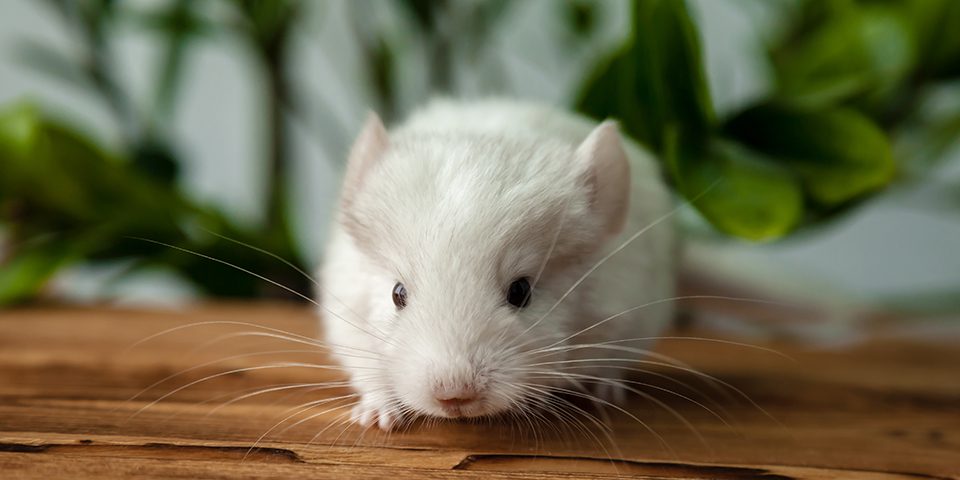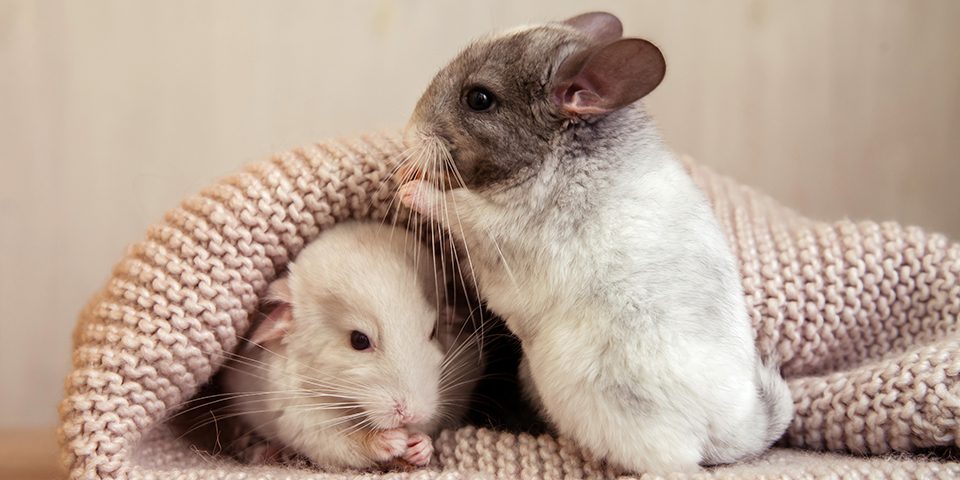Authors: Dianne Cook, LVT, and Cayla Iske, PhD
Updated February 28, 2024
Chinchillas are delightful, adventurous companions that are capable of living a long and happy life alongside you! In this article, you’ll learn about seven of the most common chinchilla health issues to watch out for so you can ensure the longest, happiest life possible for your chinchilla.
1. Bladder Stones/Sludge
Like rabbits and guinea pigs, chinchillas are prone to the development of bladder sludge or bladder stones. In the wild these species naturally ingest more moisture through living plant material, and live a highly active lifestyle. These lifestyle characteristics reduce chances for bladder sludge formation compared to the life that domestic chinchillas live.
While less is known about some aspects of chinchilla nutrition, it’s thought they also absorb nearly all calcium in the diet. One key difference between chinchillas and rabbits or guinea pigs is that chinchilla urine is not typically the method of excess calcium removal for their bodies. Chinchillas instead excrete excess calcium via the feces rather than the urine. However, they can still develop urinary issues, so it is important to be aware of this and consider actions to avoid or alleviate sludge and stones.
There is some debate about a genetic component that may predispose chinchillas to sludge or stone development, but this has not been scientifically validated.
Signs of bladder sludge can include:
- Blood in the urine
- Frequent urination
- Painful urination
- Visible crystals in the urine
Any of these signs warrant a trip to your trusted veterinarian.
2. Dental Issues
Chinchillas’ teeth are all open rooted, which means they are continuously growing and need to chew on things in order to wear them down. A lack of fibrous food in the form of grass hay and appropriate enrichment chew items may result in the abnormal growth of teeth, malocclusion (imperfect positioning of the teeth), and potentially other types of dental diseases.
If dental disease occurs, a chinchilla may not be able to chew or eat food properly. As we’ll discuss later, the constant intake of fiber is essential for the gastrointestinal (GI) tract of chinchillas. If dental disease negatively affects a chinchilla’s ability to eat, it can lead to a life-threatening issue known as GI stasis. For more in-depth information on dental health issues in chinchillas, refer to our dental disease blog.

3. Skin and Coat Issues
The dense, lush fur of chinchillas is perhaps their most notable quality! But, these qualities can also lead to issues if their coat is not properly maintained.
Because chinchilla fur is so thick, any moisture their body comes in contact with can become trapped and will not properly dry. This can lead to pyoderma (infection of the skin) or dermatitis (inflammation of the skin) so it’s important to never let your chinchilla get wet.
Never give your chinchilla a soap and water bath. Instead, allow your chinchilla to take dust baths to facilitate natural cleaning. Too much dust bathing can dry out your chinchilla’s skin, so limit baths to 2-4 times per week. Check out our high-quality chinchilla dust, which is collected with the use of sustainable practices.
If your chinchilla’s fur gets wet unintentionally, please make sure to contact your veterinarian for guidance, and take your wet chinchilla to the vet office for preventative treatment if your vet deems it necessary.
Keep an eye out for alopecia (hair loss or bald patches) in your fur baby’s luxurious coat. Chinchillas in the wild employ a mechanism to escape from predators called “fur slip” in which they release part of their fur from their skin. In a domestic setting, fur slip might result from improper handling or highly stressful events. To avoid fur slipping, be sure to always support your pet’s body when handling them and never grab them by the tail, fur, or skin.
Chinchillas can also carry fungal ringworm. Because ringworm is a zoonotic organism, it can be transferred to humans and other animals. Ringworm can cause hair loss and scaly skin. If any bald patches are observed, contact your veterinarian right away to determine the cause of hair loss and ensure proper treatment.
4. Gastrointestinal Stasis
One characteristic that can set chinchillas up for a plethora of health issues is their highly sensitive digestive tracts.
The GI system of chinchillas evolved to process large amounts of fiber in the form of plants. In their native, harsh habitat high in the mountains of South America, chinchillas largely consume hearty, fibrous vegetation that can survive the climate. In domestic settings, chinchillas should consume unlimited amounts of grass hays like Hearty and Crunchy or Soft and Lush Timothy Hay due to their high fiber content.
Fiber as a material is not calorically dense, nor highly digestible. In order to meet their energy requirements, the food that chinchillas eat moves through the system quickly to make room for more consumed food.
This constant movement of the GI tract and the cycle of ingestion and defecation is key to maintaining your chinchilla’s health. Large amounts of fiber ensures proper GI movement and is key to keeping the microbiome of a chinchilla’s GI system happy and healthy.
What is the microbiome?
“Microbiome” refers to billions and billions of microscopic living organisms (e.g. bacteria, protozoa, fungi, etc.) that reside throughout the intestines. These tiny organisms contribute to hundreds of different processes in the body, including fiber fermentation in the hindgut.
When a chinchilla’s diet is lacking adequate fiber or includes too many simple carbohydrates, the natural “good” bacteria of the microbiome are compromised, opening the door for the growth of potentially dangerous bacteria.
This disruption of the microbiome is referred to as “dysbiosis” and it can have numerous negative effects, including alteration of fiber digestion. A lack of dietary fiber in the form of a high-quality grass hay is closely linked to GI stasis in small herbivores like chinchillas.
Signs of GI Stasis
Pet parents should carefully monitor their little ones daily for signs of GI stasis. Any changes in routine eating patterns or behaviors, even as short as one day, can be detrimental.
When the movement of the GI system slows or ceases (stasis), painful gas can build up in the digestive tract and further impede intestinal movement. Because chinchillas cannot vomit or eructate (belch), any gas that builds up in the GI system must continue to move through the entire system to be alleviated at the rectum.
Symptoms of GI stasis may include:
- Lack of appetite
- Reduction of water intake
- Reduced activity
- Lethargy
- Hunched posture
- Abdominal stretching
- Changes in feces size or amount.
Though these symptoms are not exclusive to GI stasis, if you observe any of the aforementioned changes, your trusted vet should be contacted immediately.
5. Diarrhea
Dysbiosis associated with low fiber or high carbohydrate diets can lead not only to GI stasis, but also to diarrhea.
Simple carbohydrates that can be found in non-uniform mixed foods are highly fermentable in the hindgut. Too much fermentation in the hindgut can cause a large influx of water to enter into the colon, resulting in loose stools. Diarrhea can indicate a disruption in the microbiome and inhibits cecotrophy (the ingestion of cecotropes or “night stools”), two processes that need to function properly in order to maintain your chinchilla’s health.
No matter what the cause, if your animal has diarrhea or even loose stools that resemble a “cow pie,” they should immediately be taken to your veterinarian. Diarrhea can quickly lead to dehydration, which increases the risk of GI stasis and many other health issues.
Any kind of sudden dietary change can lead to diarrhea or stasis. When changing your pet’s hay, fortified food, greens/veggies types, or introducing a new treat, make sure to plan a gradual food transition to allow the intestinal tract to adapt and adjust.
6. Heat Stroke
Chinchillas originate from the Andes Mountains of South America where temperatures are between 35 – 45°F (2 – 7° C). Their dense fur allows them to thrive at these lower temperatures, but this lush fur and the inability to sweat also causes them to be intolerant of warmer temperatures.
Domestic chinchillas tend to do best when the house is kept between 55 – 70°F (13 – 21°C). Temperatures of households with a chinchilla should never exceed 80°F (27°C). Humidity should also be kept around 40 – 60% to keep chinchillas comfortable.
If your chinchilla is exposed to sunlight, whether indoors or out, they should always be given access to shade. High temperatures or humidity can quickly lead to heatstroke if your little one does not have the option to escape from the sun’s rays.
Signs of heatstroke in chinchillas include:
- Panting or open-mouthed breathing
- High body temperature
- Inactivity
If your chinchilla is experiencing these issues, notify your vet right away and take measures to reduce environmental temperature and humidity.

7. Respiratory Issues
As a rodent, chinchillas are obligate nasal breathers with a sensitive respiratory system. This puts them at risk for various respiratory infections that can be caused by many environmental factors.
While the symptoms of a respiratory infection may not seem serious, they should not be taken lightly. Untreated respiratory concerns can lead to pneumonia and are frequently contagious to other chinchillas. If you see or hear your chinchilla sneezing, or if you observe any of the behaviors we list below, your chinchilla should be seen by a qualified veterinarian for care.
Upper respiratory issues or infection in chinchillas may manifest as:
- Sneezing
- Nasal discharge
- Difficulty breathing
- Watery eyes
- Reduced activity
- Reduced food intake
Chinchillas are amazing pets and unique companions, but they require tailored care. Just like us, the array of chinchilla diseases and ailments that can occur do not affect just organ or system in the body. Being aware of the signs or symptoms of their most common health concerns is half the battle!
As with any pet, monitor your chinchilla daily so you can recognize when they deviate from normal behaviors or eating schedules. With proper husbandry and diet, chinchillas can be wonderful companions that will be part of your family for many years.

